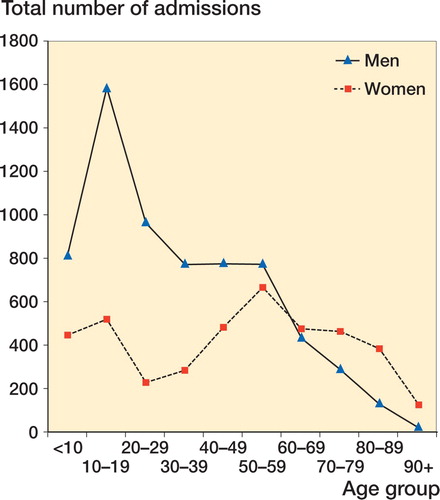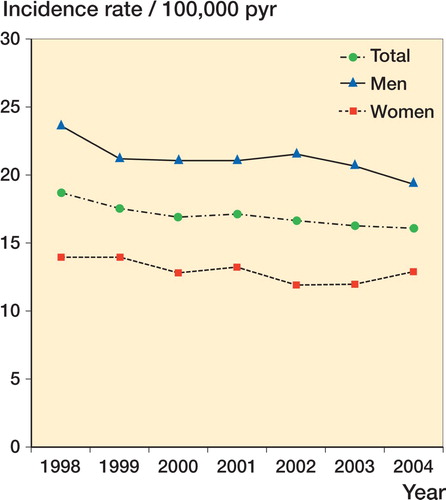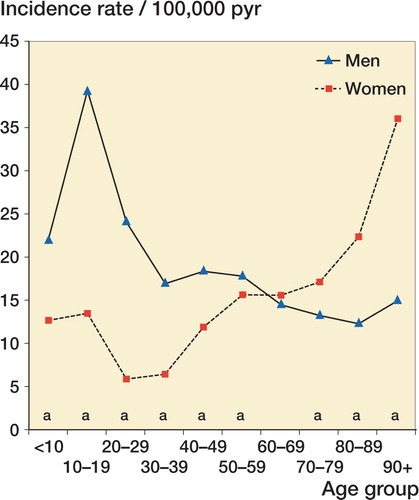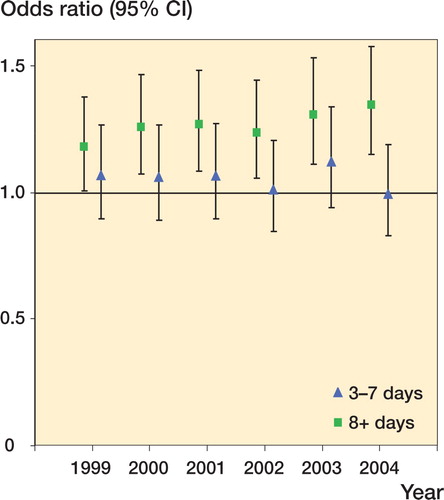Abstract
Background and purpose There is a lack of national epidemiological data on the characteristics of patients with tibial shaft fractures. We therefore analyzed data on Swedish patients with tibial shaft fractures in this nationwide population study based on data from 1998 through 2004.
Methods Data on all patients with tibial shaft fractures were extracted from the Swedish National Hospital Discharge Register.
Results We identified 10,627 hospital admissions for tibial shaft fractures, corresponding to an annual incidence rate of 17 per 100,000 person‐years (pyr). The number of hospital admissions decreased by 12% during the period 1998–2004, mostly from a reduction in male incidence. The median (SD) age at admission was 28 (22) years for men and 51 (26) years for women. The two major mechanisms of injury were falls on the same level (48%) and transport accidents (21%). Surgical procedures were dominated by osteosynthesis with nail (48%), followed by closed reduction and plaster cast (27%), and external fixation (12%). 12% of all tibial shaft fractures were classified as open, corresponding to an incidence rate of 2.3 per 100,000 pyr, which declined during 1998–2004.
Interpretation This nationwide study of tibial shaft fractures shows a falling off of fracture incidence, a finding that can be used to advantage by healthcare providers.
In a recent review, the annual incidence of tibial shaft fractures was reported to be 22 per 100,000 inhabitants (Court‐Brown and Caesar Citation2006). To date, rather few epidemiological studies have been undertaken to examine the incidence of this injury (Knowelden et al. Citation1964, Bengner et al. Citation1990, Donaldson et al. Citation1990, Court‐Brown and McBirnie Citation1995, Emami et al. Citation1996, Singer et al. Citation1998, van Staa et al. Citation2001), and with varying results. Most of the earlier epidemiological studies were retrospective or case series from single hospitals, and prior to the present study no analyses on a nationwide basis had been undertaken.
Basic epidemiological data on frequency and distribution, mechanisms of injury, surgical procedures, and on temporal variations are of importance in assisting the planning and delivery of healthcare. The purpose of this investigation was to provide an update on incidence, admissions, causes of fracture, and operation of these fractures on a nationwide basis in Sweden during the period 1998–2004.
Patients and methods
Source of data
Data were obtained from the Swedish National Hospital Discharge Register (SNHDR) (Socialstyrelsen a), which allows the study of various groups of patients on the basis of their diagnoses and their designated operation codes, as the register covered more than 98% of all hospital admissions in Sweden for the study period. Each Swedish resident can be identified by a unique 10‐digit national registration number, making it possible to retrieve demographic data, diagnoses at discharge, and surgical procedures. The registration number can be used for epidemiological studies and follow‐up through the International Classification of Diseases (ICD) coded register. The ICD coded register adopted the ICD‐10 classification in 1997. However, one county (Skåne) used the ICD‐9 version throughout 1997 and changed to ICD‐10 in 1998; thus, we analyzed all data from 1998 onwards.
During the study period from January 1, 1998 through December 31, 2004, we identified all inpatient visits with the relevant ICD‐10 diagnostic codes from the SNHDR concerning tibial shaft fractures: S82.20 (closed), S82.21 (open), and S82.2 (unspecified). Diagnostic codes on proximal or distal tibial fractures and re‐admissions of the same patient after a primary hospitalization were not included.
Causes of fracture were analyzed according to ICD E‐codes (external codes) and grouped into the following 6 categories: fall on the same level, fall from height, unspecified fall, transport accident, miscellaneous, and unreported cause. When choosing the relevant surgical intervention codes (Socialstyrelsen b) procedure codes related to tibial shaft fractures were analyzed (NGJ09‐NGJ99, TNX35, and TNX40).
Sex‐ and age‐specific fracture incidence rates for the Swedish population were calculated by dividing the number of admissions with relevant fractures by the total number of person‐years (pyr) of follow‐up. The total person‐time was the sum of the years contributed by all Swedish inhabitants during the study period. Detailed estimates of the population at risk during the study period were provided by Statistics Sweden (Statistiska Centralbyrån). Thus, we calculated incidence rates in relation to the entire Swedish population. Number of admissions and patients, mechanisms of injury, surgical procedures, and length of hospital admissions were calculated from the patient population.
The following categories of age were used: < 10, 10–19, 20–29, 30–39, 40–9, 50–59, 60–69, 70–79, 80–89, and > 90 years. The length of admission was classed as being of either short duration (0–2 days), medium duration (3–7 days), or long duration (> 8 days).
The study was approved by the local Ethics Committee of Stockholm North (DN 2005/1332–31/2).
Statistics
By descriptive analysis, we investigated the frequency of admissions, the number of patients, and the number of operations. Incidence rates and incidence rate ratios with 95% confidence intervals (CIs) according to sex and age‐group were calculated using the population at risk as the denominator. Adjustment for age was performed as appropriate. Logistic regression analysis was used to investigate the length of admission. The short duration category was compared with the medium and long duration categories in two models. The odds ratios (ORs) were calculated together with their 95% CIs. All independent measures were modeled as a series of dummy variables, but year of admission was also modeled continuously to estimate trend.
A summary variable was used to record how many admissions for tibial shaft fractures had been undertaken each year. This variable was the dependent variable in linear regression analysis, with the year of discharge as the independent variable. A similar sum variable was created for incidence rates of fracture.
Mann‐Whitney U test was used to assess the association between length of admission in relation to sex, open/closed fractures, and surgical/non‐surgical treatment. This test was used for comparisons between age at admission and sex of the patient. All values are presented as median with SD. The level of significance was p < 0.05. All statistical analyses were performed using SPSS version 11.5 (SPSS Inc., Chicago, IL) and STATA 9 (StataCorp, College Station, TX) for Windows.
Results
Admissions and patients
Over a period of 7 years, 10,627 Swedish patients sustained a tibial shaft fracture that required inpatient admission. The overall median (SD) age at admission was 37 (25) years. Men had a younger median age (28 (22) years) than women (51 (26) years) (p < 0.001). Moreover, more men (62%) than women (38%) were admitted to a Swedish hospital due to this kind of fracture. Most hospital admissions involved males in the 10–19‐year age group and females in the 50–59‐year age group (,).
Figure 1. Number of hospital admissions for tibial shaft fractures in Sweden during the period 1998-2004, stratified by sex and age group.

Table 1. Descriptive data on tibial shaft fractures in Sweden during the period 1998–2004, related to age
During the study period the total number of admissions decreased by 12%, as shown by linear regression analysis (B = –29, p = 0.008). The B‐value (regression coefficient) indicates that there was a reduction in admissions of 29 per year on average, during 1998–2004. Male admissions decreased by 11% (B = –18, p = 0.05) and female admissions by 14% (B = –12, p = 0.09) during the study period ().
Table 2. Descriptive data of tibial shaft fractures in Sweden during the period 1998–2004 related to year of occurrence
Incidence rates
The crude total incidence rate for tibial shaft fractures was 17 per 100,000 person‐years (pyr) during the study period (age‐adjusted: 18). Men had a crude incidence rate of 21 and women of 13 per 100,000 pyr (age‐adjusted: men 24, women 15) with an overall incidence risk ratio of 1.6 between men and women (p < 0.001) (). Linear regression analysis revealed that the total incidence rate (B = –0.4, p = 0.003), and the incidence rate for men (B = –0.5, p = 0.03) and for women (B = –0.3, p = 0.06) decreased during 1998–2004 ( and).
Figure 2. Crude incidence rates per 100,000 person-years (pyr) of tibial shaft fractures in Sweden during the period 1998-2004, stratified by sex and year. Data were analyzed by linear regression analysis (total: B = -0.4, p = 0.003; men: B = -0.5, p = 0.03; women: B = -0.3, p = 0.06).

There were two main peaks of fracture distribution: the first was in young males and the second was in older women ( and ). Male incidence rate peaked at 10–19 years at 39 per 100,000 pyr and reached its lowest value between 80 and 89 years of age at 12 per 100,000 pyr. Female incidence rates, however, reached their lowest values between 20 and 39 years of age at 6 per 100,000 pyr, then showed a steady increase and a peak at > 90 years of age at 36 per 100,000 pyr. The incidence rate of sustaining a tibial shaft fracture was higher for men than for women up to the 50–59‐year age group. From the 70–79‐year age group and onwards, it was higher for women.
Mechanisms of injury
The commonest mechanism of injury for all fractures was a fall on the same level (48%); a transport accident was the next common cause of injury (21%) (). Falls on the same level decreased with time by 13% (B = –19, p = 0.04) whereas the proportion of transport accidents that caused injury remained stable.
Table 3. Mechanisms of injury
Surgical procedures
58% of all admissions resulted in some kind of surgical procedure. These were dominated by osteosynthesis with nail (48%), followed by closed reduction and plaster cast (27%), external fixation (12%), osteosynthesis with plate and screws (8%), and other fracture surgery (5%). Patients undergoing a surgical procedure were hospitalized for a longer time than non‐surgical patients (median 4 (9) days vs. 2 (9) days) (p < 0.001).
Open versus closed fractures
72% of all admissions were classified as closed fractures, 12% as open fractures, and 16% were unspecified. The median (SD) age for open fractures was 40 (21) as compared to 36 (25) years for closed fractures (p < 0.001). Men had 70% of all open fractures and 61% of all closed fractures. The age‐adjusted incidence rate for open tibial shaft fractures was 2.3 (men 3.4, women 1.4). The number of open tibial fractures decreased by 12% (B = –4, p = 0.02), as did the age‐adjusted total incidenc rate (B = –0.05, p = 0.03) during the period 1998–2004.
Transport accidents were the commonest injury for open fractures (43%), followed by a fall on the same level (25%). Of all open fractures, 76% (n = 977) underwent surgical procedures and 24% (n = 304) were treated non‐surgically. The most predominant surgical procedure was osteosynthesis with nail (51%, n = 492), followed by external fixation (31%, n = 306), manipulation and plaster cast (11%, n = 105), osteosynthesis with plate and screws (4%, n = 41) and other fracture surgery (3%, n = 33). Patients with open tibial fractures were hospitalized for longer than patients with closed fractures (median 6 (12) days and 3 (8) days, respectively) (p < 0.001).
Length of hospital stay
Patients were hospitalized for tibial shaft fractures for a median period of 4 (9) days. Men were hospitalized for a shorter time than women (3 (8) days and 4 (10) days, respectively) (p < 0.001). The length of stay increased continuously during the period 1998–2004 ().
Discussion
Our study includes the largest number of tibial shaft fractures published so far, and more importantly, this cohort represents more than just a random sample—as this survey includes close to 100% of all inpatients with tibial shaft fractures in the entire Swedish population during the period 1998–2004. Our main finding was a reduction in the number of admissions for tibial shaft fractures in Sweden during 1998–2004. This decline was most pronounced in males. Over time, we found an even proportion of cases from transport accidents, but admissions due to a fall on the same level decreased during the study period.
A previous report on tibial shaft fractures found no changes in fracture incidence in the city of Malmö, Sweden, when comparing the period 1950–55 with 1980–83 (Bengner et al. Citation1990). Still, the incidences for both men and women were higher in both time periods compared to our findings. Emami et al. (Citation1996) demonstrated a decrease in incidence of tibial shaft fractures when comparing the period 1971–1975 with 1986–1990 in one county of Sweden. The reduction in fracture incidence, especially in young men during the second period, was attributed almost entirely to the decline in the number of fractures seen in young motorcyclists. However, compared to our data, the incidence figures were higher (Emami et al. Citation1996)—as in another report (Singer et al. Citation1998).
There are differences in fracture incidence in different parts of the world but even studies within the same country have shown wide variations, the reasons for which are not fully understood (Court‐Brown and Caesar Citation2006). Due to its stable population, its public healthcare system, and its comprehensive population registers, Sweden is an ideal country in which to perform epidemiological surveys. Patient registries provide valuable data to medical researchers for the purposes of both quality control and scientific research. The SNHDR has all the advantages of a longitudinal register. It is an administrative database that is used extensively for medical research. General and specific validation surveys suggest that almost 90% of the registered diagnoses and surgical procedure codes are correct when compared with medical files (Socialstyrelsen a).
We rule out the possibility that technical problems due to the study design could explain our results. There may be several reasons for our findings, however. The decline in fracture incidence concerning inpatient data may be driven by a true decrease in fracture incidence due to less falls on the same level by males. Moreover, our findings may be due to a decrease in fracture severity and/ or to the economically motivated shift in emphasis from inpatient treatment to outpatient treatment. During the last 2–3 decades, the number of beds in Swedish hospitals has decreased considerably (Molin and Johansson Citation2004). In recent years, a shift has occurred in Swedish hospital care from inpatient to outpatient settings, but the latter are not included in the SNHDR database.
The number of cars and motorbikes increased substantially in Sweden during the study period, as did the total number of injured persons due to road traffic accidents (The Swedish Institute for Transport and Communications Analysis). Even so, the number of admissions for tibial fractures with transport accident as external cause was stable, which may be explained by improved road traffic safety.
The median age of 37 years at hospital admission and the uneven sex distribution with two‐thirds of all such admissions involving fractures in men has also been described by other authors (Court‐Brown and McBirnie Citation1995, Karladani et al. Citation2001). High numbers of fractures were experienced by young men, whereas women showed a more homogeneous distribution of fractures in the different age groups. Fractures were less common in both sexes in higher age groups. These findings agree with previously published data from a large cohort of tibial fractures (Grutter et al. Citation2000). We found a distribution of fracture incidence rates that is in accordance with those of other observers (Singer et al. Citation1998, Court‐Brown and Caesar Citation2006), showing a unimodal pattern regarding age and sex—with men having a fracture peak at a very young age and women at a very old age.
The peak in fracture incidence in males between 10–19 years of age was mainly caused by a fall on the same level (49%) or a transport accident (27%) (data not shown). In young people fractures of the long bones predominate, usually after substantial trauma, and they occur more frequently in men than in women (van Staa et al. Citation2001). Wladis et al. (Citation2002) showed that in a large cohort of patients admitted after motorcycle crashes in Sweden, the incidence of admissions was highest in young men with mostly fractures of the tibia and fibula. Court‐Brown and McBirnie (Citation1995) described road traffic accidents and sports‐related injuries as the major external causes of tibial fractures.
Van Staa et al. (2001) showed that the overall fracture incidence in women climbs steeply at higher ages, as bone density decreases. In a large prospective study, Seeley et al. (Citation1991) found an association between risk of lower leg fractures and reduced bone mass. Even so, Jensen et al. (Citation1982) reported that shaft fractures are not associated with reduction in bone mass or earlier onset of menopause. In contrast, concerning tibial shaft fractures in our material we found a distinctive feature for osteoporotic fractures in older women: incidence rates that are greater in women than in men and rates that increase steeply with age (Cooper Citation1993). In our study, 77% of all fractures in women over 90 years of age could be explained by a fall on the same level (data not shown).
Bhandari et al. (Citation2001) conducted a survey of orthopedic surgeons and reported their preference in using intramedullary nailing for closed fractures of the tibial shaft, when nonoperative treatment was considered inappropriate. In addition, the authors found it interesting that a substantial proportion of surgeons chose external fixation for simple closed fractures and for closed fractures associated with compartment syndrome. The same trend regarding surgery was seen in our material. Surgical management options including implants were dominated by intramedullary nail fixation, followed by external fixation.
Open tibial fractures, which are particularly difficult to manage, happened at a higher age in general and in a higher proportion of males, which has also been shown previously (Court‐Brown and McBirnie Citation1995). Court‐Brown et al. (Citation1998) reported an incidence of 12 per 100,000 pyr for all open long bone fractures, open tibial shaft fractures being the most common type. This incidence is clearly higher than in our data set. As expected, open fractures were more likley to be associated with transport accidents than tibial fractures in general. Due to the severity of the injury, length of hospital stay for open fractures was longer than for closed fractures, as has been shown previously (Karladani et al. Citation2001). As expected, due to the severity of open fractures most were treated with surgery. Intramedullary nailing is a popular procedure for treatment of open tibial fractures; still, in severe open fractures there is a considerable variability in the choice of using a tibial nail or external fixation (Bhandari et al. Citation2001). Our analysis revealed that osteosynthesis with a nail was the preferred treatment for open fractures. External fixation was more commonly used with open fractures than with closed fractures. One‐quarter of open tibial fractures were treated nonoperatively. This group most probably included patients with undisplaced fractures with only small wounds (Gustillo I) who were not treated in the operating theater; these, however, could not be analyzed using the present study design.
The overall low numbers and decreasing incidence rate of open tibial fractures in Sweden might suggest a need for regionalization of treatment of these severe injuries. Orthopedic training may be compromised because of the reduced fracture incidence. Patients might benefit from the competence gathered at specialized centers with intensive multidisciplinary involvement to cover all the diagnostic and treatment options required (Gopal et al. Citation2004).
The median length of stay for tibial shaft fractures of only 3 days was more than halved compared with data from 1986–1990 (Emami et al. Citation1996). This may be explained by the economically motivated effort to reduce healthcare costs by reducing inpatient time.
This nationwide study of tibial shaft fractures shows a promising falling off of fracture incidence, which can be used to advantage by providers of healthcare. The epidemiological data presented in this analysis should serve as a reference for future studies.
Contributions of authors
RJW designed the study, compiled and analyzed the data, and wrote the manuscript. SMM also designed the study, participated in the analysis, and edited the manuscript. AE participated in the analysis. ZAD participated in the analysis and in writing of the manuscript. AS contributed to the design of the study and edited the manuscript. KÅJ participated in the analysis, and in writing and editing of the manuscript.
This study was supported by grants from the Capio Research Foundation and the Sven Norén Donation Fund.
No competing interests declared.
- Bengner U, Ekbom T, Johnell O, Nilsson B E. Incidence of femoral and tibial shaft fractures. Epidemiology 1950–1983 in Malmo, Sweden. Acta Orthop Scand 1990; 61: 251–4
- Bhandari M, Guyatt G H, Swiontkowski M F, Tornetta P, 3rd, Hanson B, Weaver B, Sprague S, Schemitsch E H. Surgeons’ preferences for the operative treatment of fractures of the tibial shaft. An international survey. J Bone Joint Surg (Am) 2001; 83: 1746–52
- Cooper C. Epidemiology and public health impact of osteoporosis. Baillieres Clin Rheumatol 1993; 7: 459–77
- Court‐Brown C M, Caesar B. Epidemiology of adult fractures: A review. Injury 2006; 37: 691–7
- Court‐Brown C M, McBirnie J. The epidemiology of tibial fractures. J Bone Joint Surg (Br) 1995; 77: 417–21
- Court‐Brown C M, Rimmer S, Prakash U, McQueen M M. The epidemiology of open long bone fractures. Injury 1998; 29: 529–34
- Donaldson L J, Cook A, Thomson R G. Incidence of fractures in a geographically defined population. J Epidemiol Community Health 1990; 44: 241–5
- Emami A, Mjoberg B, Ragnarsson B, Larsson S. Changing epidemiology of tibial shaft fractures. 513 cases compared between 1971–1975 and 1986–1990. Acta Orthop Scand 1996; 67: 557–61
- Gopal S, Giannoudis P V, Murray A, Matthews S J, Smith R M. The functional outcome of severe, open tibial fractures managed with early fixation and flap coverage. J Bone Joint Surg (Br) 2004; 86: 861–7
- Grutter R, Cordey J, Buhler M, Johner R, Regazzoni P. The epidemiology of diaphyseal fractures of the tibia. Injury (Suppl3) 2000; 31: C64–7
- Jensen G F, Christiansen C, Boesen J, Hegedus V, Transbol I. Epidemiology of postmenopausal spinal and long bone fractures. A unifying approach to postmenopausal osteoporosis. Clin Orthop 1982, 166: 75–81
- Karladani A H, Granhed H, Karrholm J, Styf J. The influence of fracture etiology and type on fracture healing: a review of 104 consecutive tibial shaft fractures. Arch Orthop Trauma Surg 2001; 121: 325–8
- Knowelden J, Buhr A J, Dunbar O. Incidence of fractures in persons over 35 years of age. A report to the M.R.C working party on fractures in the elderly. Br J Prev Soc Med 1964; 18: 130–41
- Molin R, Johansson L. Swedish Health Care in Transition. Resources and Results with International Comparisons. Stockholm, EO Print 2004; ISBN 91-7188-807-1
- Seeley D G, Browner W S, Nevitt M C, Genant H K, Scott J C, Cummings S R. Which fractures are associated with low appendicular bone mass in elderly women? The Study of Osteoporotic Fractures Research Group. Ann Intern Med 1991; 115: 837–42
- Singer B R, McLauchlan G J, Robinson C M, Christie J. Epidemiology of fractures in 15,000 adults: the influence of age and gender. J Bone Joint Surg (Br) 1998; 80: 243–8
- Socialstyrelsen a. The National Board of Health and Welfare. The Swedish Hospital Discharge Register. http:// www.sos.se/epc/english/pareng.htm
- Socialstyrelsen b. The National Board of Health and Welfare. The Swedish Classification of Surgical Procedures Revised Version of 2004. http://www.socialstyrelsen.se/ publicerat/2004/8608/2004-4-1.tmh.
- Statistiska Centralbyrån. Statistics Sweden. Population statistics. http://www.ssd.scb.se/databaser/makro/Produkt. asp?produktid=BE0101.
- The Swedish Institute for Transport and Communications Analysis (SIKA). http://www.sika-institute.se/Templates/ FileInfo.aspx?filepath=/Doclib/Import/100/tk21tab1.xls.
- van Staa T P, Dennison E M, Leufkens H G, Cooper C. Epidemiology of fractures in England and Wales. Bone 2001; 29: 517–22
- Wladis A, Bostrom L, Nilsson B. Injuries in 8927 patients admitted after motor-cycle crashes in Sweden 1987–1994 inclusive. Eur J Surg 2002; 168: 187–92


